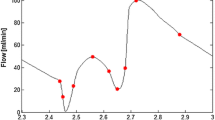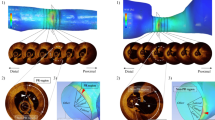Abstract
Background
Endothelial shear stress (ESS) may play a key role in the pathobiology of stent restenosis (SR). Nevertheless, limited data are available about ESS and its relation to SR.
Patients and methods
We enrolled 14 patients who underwent successful percutaneous coronary intervention (PCI) in this study. Three-dimensional (3D) reconstruction of 14 coronary arteries before and after stent implantation was performed. Using computational fluid dynamics, mean ESS was calculated proximally, in tertiles within and distal to the stent, both before and after stent implantation.
Results
Stent implantation resulted in a significant ESS decrease in the entire atherosclerotic lesion (1.83 vs. 1.26 Pa, p = 0.02). Regarding the five territories in which the entire lesion was divided, ESS decrease was marginally significant in the area of the second in-stent tertile, and in the area 5 mm distal to the stent, whereas ESS decrease was not significant in the area 5 mm proximal to the stent, and in the area of the first and third in-stent tertile. At 12 months, two patients had SR, but restenosis was not related to ESS decrease.
Conclusion
ESS decreases after stent implantation but not uniformly, with the major reduction being in the middle tertile of the stent, and distal to the stent. In-stent ESS decrease may create local hemodynamic conditions leading to in-stent and in-segment restenosis.
Zusammenfassung
Hintergrund
Die Scherbelastung des Endothels („endothelial shear stress“, ESS) kann eine wichtige Rolle in der Pathobiologie der Stent-Restenosen (SR) spielen. Dennoch sind die vorliegenden Daten über die ESS und ihren Zusammenhang mit SR begrenzt.
Patienten und Methoden
Die Autoren rekrutierten 14 Patienten nach einer erfolgreichen perkutanen koronaren Intervention (PCI). Vor und nach der Stentimplantation wurde eine 3‑D-Rekonstruktion von 14 Koronararterien durchgeführt. Mit numerischer Strömungsdynamik wurde die mittlere ESS vor und nach der Stentimplantation wie folgt berechnet: proximal, in Terzilen innerhalb und distal des Stents.
Ergebnisse
Die Stentimplantation führte zu einer signifikanten ESS-Abnahme in der gesamten atherosklerotischen Läsion (1,83 vs. 1,26 Pa, p = 0,02). Hinsichtlich der 5 Bereiche, in welche die Gesamtläsion geteilt wurde, war die ESS-Abnahme marginal signifikant im Bereich des 2. Terzils innerhalb des Stents und im Bereich 5 mm distal des Stents; im Gegensatz dazu war die ESS-Abnahme nicht signifikant im Bereich 5 mm proximal des Stents und in den Bereichen des 1. und 3. Terzils innerhalb des Stents. Zwölf Monate später kam eine SR bei 2 Patienten vor; die Restenose war jedoch nicht mit einer ESS-Abnahme assoziiert.
Schlussfolgerung
Die ESS nimmt nach der Stentimplantation ab, nicht jedoch einheitlich, mit der höchsten Abnahme im mittleren Terzil und distal des Stents. Die ESS-Abnahme innerhalb des Stents kann lokale hämodynamische Bedingungen erzeugen, die zu Restenosen innerhalb des Stents und innerhalb von Segmenten führen können.

Similar content being viewed by others
References
Mozaffarian D, Benjamin EJ, Go AS et al (2015) Heart disease and stroke statistics – 2015 update: A report from the American Heart Association. Circulation 131(4):e29–e322. doi:10.1161/CIR.0000000000000152
Nowbar AN, Howard JP, Finegold JA et al (2014) 2014 global geographic analysis of mortality from ischaemic heart disease by country, age and income: Statistics from World Health Organisation and United Nations. Int J Cardiol 174(2):293–298. doi:10.1016/j.ijcard.2014.04.096
Chatzizisis YS, Coskun AU, Jonas M et al (2007) Role of endothelial shear stress in the natural history of coronary atherosclerosis and vascular remodeling: Molecular, cellular, and vascular behavior. J Am Coll Cardiol 49(25):2379–2393
Chatzizisis YS, Jonas M, Coskun AU et al (2008) Prediction of the localization of high-risk coronary atherosclerotic plaques on the basis of low endothelial shear stress: An intravascular ultrasound and histopathology natural history study. Circulation 117(8):993–1002. doi:10.1161/CIRCULATIONAHA.107.695254
Koskinas K, Chatzizisis YS, Antoniadis AP, Giannoglou GD (2012) Role of endothelial shear stress in stent restenosis and thrombosis. J Am Coll Cardiol 59:1337–1349. doi:10.1016/j.jacc.2011.10.903
Wijns W, Kolh P, Danchin N et al (2010) Guidelines on myocardial revascularization. Eur Heart J 31(20):2501–2555. doi:10.1093/eurheartj/ehq277
Gijsen FJ, Oortman RM, Wentzel JJ et al (2003) Usefulness of shear stress pattern in predicting neointima distribution in sirolimus-eluting stents in coronary arteries. Am J Cardiol 92(11):1325–1328
Stone PH, Coskun AU, Kinlay S et al (2003) Effect of endothelial shear stress on the progression of coronary artery disease, vascular remodeling, and in-stent restenosis in humans: In vivo 6‑month follow-up study. Circulation 108(4):438–444
Bourantas CV, Papafaklis MI, Kotsia A et al (2014) Effect of the endothelial shear stress patterns on neointimal proliferation following drug-eluting bioresorbable vascular scaffold implantation: An optical coherence tomography study. JACC Cardiovasc Interv 7(3):315–324. doi:10.1016/j.jcin.2013.05.034
Papafaklis MI, Bourantas CV, Theodorakis PE et al (2010) The effect of shear stress on neointimal response following sirolimus- and paclitaxel-eluting stent implantation compared with bare-metal stents in humans. JACC Cardiovasc Interv 3(11):1181–1189. doi:10.1016/j.jcin.2010.08.018
Bourantas CV, Räber L, Zaugg S et al (2015) Impact of local endothelial shear stress on neointima and plaque following stent implantation in patients with ST-elevation myocardial infarction: A subgroup-analysis of the COMFORTABLE AMI-IBIS 4 trial. Int J Cardiol 186:178–185. doi:10.1016/j.ijcard.2015.03.160
Stone PH, Saito S, Takahashi S et al (2012) Prediction of progression of coronary artery disease and clinical outcomes using vascular profiling of endothelial shear stress and arterial plaque characteristics: The PREDICTION Study. Circulation 126(2):172–181. doi:10.1161/CIRCULATIONAHA.112.096438
Stone PH, Feldman CL (2010) In vivo assessment of local intravascular hemodynamics and arterial morphology to investigate vascular outcomes: A growing field coming of age. JACC Cardiovasc Interv 3(11):1199–1201. doi:10.1016/j.jcin.2010.08.017
LaDisa JF Jr, Guler I, Olson LE (2003) Three-dimensional computational fluid dynamics modeling of alterations in coronary wall shear stress produced by stent implantation. Ann Biomed Eng 31(8):972–980
Katranas SA, Kelekis AL, Antoniadis AP et al (2011) Non-invasive assessment of endothelial shear stress and coronary stiffness using multislice computed tomography. Int J Cardiol 152(2):281–284. doi:10.1016/j.ijcard.2011.08.032
Acknowledgements
The authors would like to thank Alexandros Androutsos for the support given on the study’s completion.
Author information
Authors and Affiliations
Corresponding author
Ethics declarations
Conflict of interest
F. Economou , S. Katranas, G. Giannoglou, K. Gemitzis, I. Styliadis, G. Efthimiadis, H. Karvounis, and A. Ziakas state that they have no competing interest.
All procedures performed in studies involving human participants were in accordance with the ethical standards of the institutional and/or national research committee and with the 1964 Helsinki declaration and its later amendments or comparable ethical standards. Informed consent was obtained from all individual participants included in the study.
Rights and permissions
About this article
Cite this article
Economou, F., Katranas, S., Giannoglou, G. et al. Impact of stent implantation on endothelial shear stress. Herz 42, 505–508 (2017). https://doi.org/10.1007/s00059-016-4487-4
Received:
Revised:
Accepted:
Published:
Issue Date:
DOI: https://doi.org/10.1007/s00059-016-4487-4
Keywords
- Coronary artery disease
- Percutaneous coronary intervention
- Drug-eluting stents
- Stent restenosis
- Endothelial shear stress




